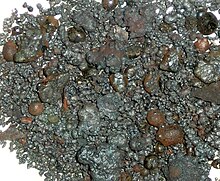Bórọ̀nù ni ẹ́límẹ̀ntì kẹ́míkà kan tó ní àmì-ìdámọ̀ B àti nọ́mbà átọ̀mù 5. Nítorípé bórọ̀nù jẹ́ dídá pátápátá pẹ̀lu ìtúká ìrànká kọ́smíkì tí kò sì jẹ́ pẹ̀lù núkléùkíkódájọpọ̀ oníràwọ̀ ,[ 12] àlùmọ́nì bóràtì . Àwọn wọ̀nyí únjẹ́ wíwà láti inú ilẹ̀ ní ilé-iṣẹ́ gẹ́gẹ́bí ìṣágbẹ , bíi bóráksì àti kẹ́rnítì .
Bórọ̀nù, 5 boron (β-rhombohedral)
[ 1] Bórọ̀nù Pípè / ˈ b ɔːr ɒ n / (BOR -on Ìhànsójú black-brown Ìwúwo átọ̀mù A r, std (B) [10.806 , 10.821 ] conventional: 10.81 Bórọ̀nù ní orí tábìlì àyè
Nọ́mbà átọ̀mù (Z ) 5 Ẹgbẹ́ group 13 (boron group) Àyè àyè 2 Àdìpọ̀ Àdìpọ̀-p Ẹ̀ka ẹ́límẹ́ntì Metalloid Ìtò ẹ̀lẹ́ktrọ́nù [He ] 2s2 2p1 Iye ẹ̀lẹ́ktrọ́nù lórí ìpele kọ̀ọ̀kan 2, 3 Àwọn ohun ìní ara Ìfarahàn at STP aláralíle Ìgbà ìyọ́ 2349 K (2076 °C, 3769 °F) Ígbà ìhó 4200 K (3927 °C, 7101 °F) Kíki when liquid (at m.p. ) 2.08 g/cm3 Heat of fusion 50.2 kJ/mol Heat of 480 kJ/mol Molar heat capacity 11.087 J/(mol·K) pressure
P (Pa)
1
10
100
1 k
10 k
100 k
at T (K)
2348
2562
2822
3141
3545
4072
Atomic properties Oxidation states −5, −1, 0,[ 2] +3 [ 3] [ 4] Àdàkọ:Infobox element/symbol-to-oxidation-state/comment Electronegativity Pauling scale: 2.04 energies Atomic radius empirical: 90 pm Covalent radius 84±3 pm Van der Waals radius 192 pm Color lines in a spectral range Spectral lines of bórọ̀nùOther properties Natural occurrence primordial Crystal structure rhombohedral Speed of sound thin rod 16,200 m/s (at 20 °C) Thermal expansion (β form) 5–7[ 5] Thermal conductivity 27.4 W/(m·K) Electrical resistivity ~106 Ω·m (at 20 °C) Magnetic ordering diamagnetic [ 6] Mohs hardness ~9.5 CAS Number 7440-42-8 History Discovery Joseph Louis Gay-Lussac and Louis Jacques Thénard [ 7] (30 June 1808) First isolation Humphry Davy [ 8] (9 July 1808) Main isotopes of bórọ̀nù
Boron-10 content may be as low as 19.1% and as [ 10] Àdàkọ:Category-inline references
Bórọ̀nù Bórọ̀nú, tó jẹ́ títòpọ̀ mọ́ ẹgbẹ́ mẹ́tálọ́ìdì , tí kò darapọ̀ bíi kẹ́míkà kò sí ní Ilé-Ayé. Ní ilé-iṣẹ́, ó ṣòro látí dá bórọ̀nù ògidì nítorípé oúndá èròjà míràn tí wọ́n ní kárbọ́nù tàbí àwọn ẹ́límẹ̀ntí míràn díẹ̀ nínú. Orísi àwọn àllótrópù bórọ̀nù lówà: bórọ̀nù amorphous boron is a brown powder and crystalline boron is black, extremely hard (about 9.5 on the Mohs scale ), and a poor conductor at room temperature. Elemental boron is used as a dopant in the semiconductor industry .
↑ Van Setten et al. 2007, pp. 2460–1↑ Braunschweig, H.; Dewhurst, R. D.; Hammond, K.; Mies, J.; Radacki, K.; Vargas, A. (2012). "Ambient-Temperature Isolation of a Compound with a Boron-Boron Triple Bond". Science 336 (6087): 1420–2. Bibcode 2012Sci...336.1420B . doi :10.1126/science.1221138 . PMID 22700924 . ↑ Zhang, K.Q.; Guo, B.; Braun, V.; Dulick, M.; Bernath, P.F. (1995). "Infrared Emission Spectroscopy of BF and AIF" . J. Molecular Spectroscopy 170 (1): 82. Bibcode 1995JMoSp.170...82Z . doi :10.1006/jmsp.1995.1058 . http://bernath.uwaterloo.ca/media/125.pdf . ↑ Melanie Schroeder. "Eigenschaften von borreichen Boriden und Scandium-Aluminium-Oxid-Carbiden" (in de). p. 139. https://www.deutsche-digitale-bibliothek.de/binary/KKUKEQ5AXZBNJVU7NJCHZB4UXT2HAGJE/full/1.pdf . ↑ Holcombe Jr., C. E.; Smith, D. D.; Lorc, J. D.; Duerlesen, W. K.; Carpenter; D. A. (October 1973). "Physical-Chemical Properties of beta-Rhombohedral Boron". High Temp. Sci. 5 (5): 349–57. ↑ Lide, David R. (ed.) (2000). Magnetic susceptibility of the elements and inorganic compounds, in Handbook of Chemistry and Physics ISBN 0849304814 . http://www-d0.fnal.gov/hardware/cal/lvps_info/engineering/elementmagn.pdf . ↑ Gay Lussac, J.L. and Thenard, L.J. (1808) "Sur la décomposition et la recomposition de l'acide boracique," Annales de chimie [later: Annales de chemie et de physique], vol. 68, pp. 169–174.
↑ Davy H (1809). "An account of some new analytical researches on the nature of certain bodies, particularly the alkalies, phosphorus, sulphur, carbonaceous matter, and the acids hitherto undecomposed: with some general observations on chemical theory" . Philosophical Transactions of the Royal Society of London 99 : 33–104. http://books.google.com/books?id=gpwEAAAAYAAJ&pg=PA140#v=onepage&q&f=false . ↑ 9.0 9.1 "Atomic Weights and Isotopic Compositions for All Elements" . National Institute of Standards and Technology. Retrieved 2008-09-21 . ↑ Szegedi, S.; Váradi, M.; Buczkó, Cs. M.; Várnagy, M.; Sztaricskai, T. (1990). "Determination of boron in glass by neutron transmission method". Journal of Radioanalytical and Nuclear Chemistry Letters 146 (3): 177. doi :10.1007/BF02165219 . ↑ Zhang, K.Q.; Guo, B.; Braun, V.; Dulick, M.; Bernath, P.F. (1995). "Infrared Emission Spectroscopy of BF and AIF" . J. Molecular Spectroscopy 170 : 82. Bibcode 1995JMoSp.170...82Z . doi :10.1006/jmsp.1995.1058 . http://bernath.uwaterloo.ca/media/125.pdf . ↑ "Q & A: Where does the element Boron come from?" . physics.illinois.edu . Retrieved 2011-12-04 .



